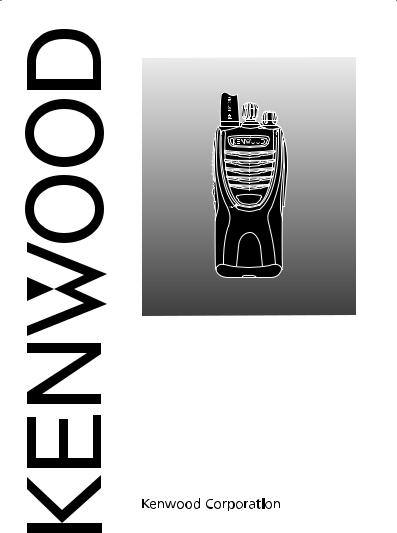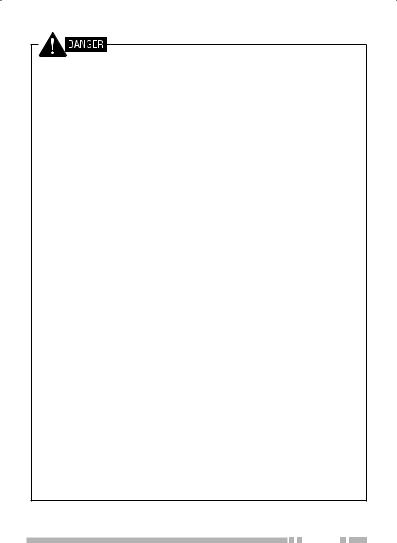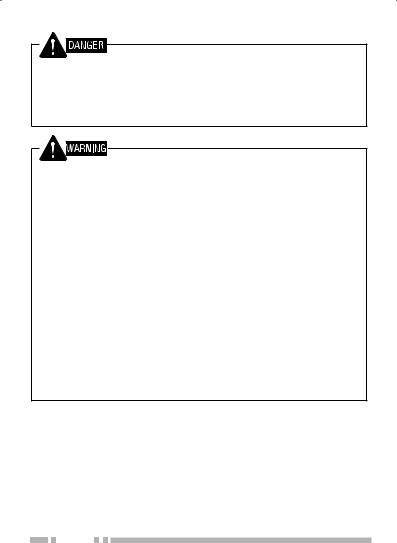Kenwood TK-3300, TK-2300 User Manual

INSTRUCTION MANUAL
VHF FM TRANSCEIVER
TK-2300
UHF FM TRANSCEIVER
TK-3300
© B62-2159-00 (K, K2)
09 08 07 06 05 04 03 02 01 00

Thank You
We are grateful for your purchase of this Kenwood product and welcome you to the Business Radio Service (BRS).
Your Kenwood 2-way Business Radio is called a “transceiver”, meaning “transmitter & receiver”. We believe this easy-to- use transceiver will provide you with dependable and reliable communications. This Kenwood transceiver is a precision device. Treat it with care, and you will enjoy years of reliable operation.
Models Covered by this Manual
TK-2300 (K): 4-channel VHF FM Transceiver
TK-3300 (K): 4-channel UHF FM Transceiver
TK-2300 (K2): 16-channel VHF FM Transceiver
TK-3300 (K2): 16-channel UHF FM Transceiver
Features
•4 channels (K) or 16 channels (K2) with 27 VHF operating frequencies (TK-2300) or 89 UHF operating frequencies (TK-3300) and 122 tone/ code settings for each channel allowing you to ignore unwanted calls.
•Built in voice scrambler gives you complete privacy for your conversations.
•Hands free operation when using an optional headset.
•Voice announcement lets you know which channel you have selected and which settings you have made when reassigning key functions and channel settings.

Operating Conditions
Open locations (no obstructions) |
Up to 6 miles (9.6 km) |
|
|
Residential areas (near buildings) |
Up to 1.5 miles (2.4 km) |
|
|
In steel/ concrete reinforced |
Up to 250,000 square feet |
buildings |
(23,220 m2) |
In high rises |
Up to 20 floors |
|
|
Note: The listed ranges are based on field testing and may vary with your operating conditions and individual transceiver.
Terminal Descriptions
Speaker/ Microphone Jacks
It is possible to use a resin-based cover for the Speaker/ Microphone jacks.
NO. |
Name |
Description |
Impedance |
I/O |
|
1 |
PTT / RXD |
External PTT Input / Serial |
CMOS |
I |
|
Data Input |
|||||
|
|
|
|
||
2 |
MIC |
External MIC Input |
1.8 kΩ |
I |
|
3 |
MICIN |
Internal MIC Output |
1.8 kΩ |
O |
|
4 |
OPTDET |
External Option Detect |
High Impedance |
I |
|
5 |
5M |
5V Output |
100 Ω |
O |
|
6 |
AE |
GND |
GND |
− |
|
7 |
TXD |
Serial Data Output |
CMOS |
O |
|
8 |
NC |
No Connection |
− |
− |
|
9 |
SPO |
Audio Input |
8 Ω |
I |
|
10 |
SPI |
Received Audio Output |
8 Ω |
O |
Antenna Terminal
50 Ω impedance
Battery Terminal
The battery terminal uses a spring plate.
The negative terminal connects to the chassis ground.
The battery is mounted on the rear side of the transceiver using a latch mounting method.

FCC License Information
Your Kenwood transceiver operates on communications frequencies which are subject to FCC (Federal Communications Commission) Rules & Regulations. FCC Rules require that all operators using Private Land Mobile radio frequencies obtain a radio license before operating their equipment. Application for license must be made on FCC form 601, schedules D and H, and Remittance form 159.
FAX: Forms can be obtained by fax from the FCC Fax-On- Demand system. Call 1-202-418-0177 from your fax machine and request document number 000601 for the form, schedules, and instructions.
MAIL: Forms can be ordered by telephone, and will be sent to you by first class mail. Call the FCC Forms Hotline at 1-800-418-FORM (1-800-418-3676).
INTERNET: Form 601 and instructions can be downloaded from the FCC Forms website at http://www.fcc.gov/formpage.html
Before filling out your Form 601 application Technical Data section, you must decide on which frequencies you will operate. See the frequency charts on pages 14 and 15.
QUESTIONS? Call the FCC for license application questions at 1-888-CALL-FCC (1-888-225-5322).
ii

One or more of the following statements may be applicable:
FCC WARNING
This equipment generates or uses radio frequency energy. Changes or modifications to this equipment may cause harmful interference unless the modifications are expressly approved in the instruction manual. The user could lose the authority to operate this equipment if an unauthorized change or modification is made.
INFORMATION TO THE DIGITAL DEVICE USER REQUIRED BY THE FCC
This equipment has been tested and found to comply with the limits for a Class B digital device, pursuant to Part 15 of the FCC Rules. These limits are designed to provide reasonable protection against harmful interference in a residential installation.
This equipment generates, uses and can generate radio frequency energy and, if not installed and used in accordance with the instructions, may cause harmful interference to radio communications. However, there is no guarantee that the interference will not occur in a particular installation. If this equipment does cause harmful interference to
radio or television reception, which can be determined by turning the equipment off and on, the user is encouraged to try to correct the interference by one or more of the following measures:
•Reorient or relocate the receiving antenna.
•Increase the separation between the equipment and receiver.
•Connect the equipment to an outlet on a circuit different from that to which the receiver is connected.
•Consult the dealer for technical assistance.
ATTENTION:
The RBRC Recycle seal found on Kenwood lithium-ion (Li-ion) battery packs indicates Kenwood’s voluntary participation in an industry program to collect and recycle Li-ion batteries after their operating life has expired.
The RBRC program is an alternative to disposing Li-ion batteries with your regular refuse or in municipal waste streams, which is illegal in some areas.
For information on Li-ion battery recycling in your area, call (toll free) 1-800-8-BATTERY (1-800-822-8837).
Kenwood’s involvement in this program is part of our commitment to preserve our environment and conserve our natural resources.
iii

Notices to the User
Government law prohibits the operation of unlicensed radio transmitters within the territories under government control.
Illegal operation is punishable by fine and/or imprisonment.
Refer service to qualified technicians only.
Safety: It is important that the operator is aware of, and understands, hazards common to the operation of any transceiver.
Precautions
•Do not charge the transceiver and battery pack when they are wet.
•Ensure that there are no metallic items located between the transceiver and the battery pack.
•Do not use options not specified by Kenwood.
•If the die-cast chassis or other transceiver part is damaged, do not touch the damaged parts.
•If a headset or headphone is connected to the transceiver, reduce the transceiver volume. Pay attention to the volume level when turning the squelch off.
•Do not place the microphone cable around your neck while near machinery that may catch the cable.
•Do not place the transceiver on unstable surfaces.
•Ensure that the end of the antenna does not touch your eyes.
•When the transceiver is used for transmission for many hours, the radiator and chassis will become hot. Do not touch these locations when replacing the battery pack.
•Do not immerse the transceiver in water.
•Always switch the transceiver power off before installing optional accessories.
•The charger is the device that disconnects the unit from the AC mains line. The AC plug should be readily accessible.
iv

Turn the transceiver power off in the following locations:
•In explosive atmospheres (inflammable gas, dust particles, metallic powders, grain powders, etc.).
•While taking on fuel or while parked at gasoline service stations.
•Near explosives or blasting sites.
•In aircrafts. (Any use of the transceiver must follow the instructions and regulations provided by the airline crew.)
•Where restrictions or warnings are posted regarding the use of radio devices, including but not limited to medical facilities.
•Near persons using pacemakers.
•Do not disassemble or modify the transceiver for any reason.
•Do not place the transceiver on or near airbag equipment while the vehicle is running. When the airbag inflates, the transceiver may be ejected and strike the driver or passengers.
•Do not transmit while touching the antenna terminal or if any metallic parts are exposed from the antenna covering.
Transmitting at such a time may result in a high-frequency burn.
•If an abnormal odor or smoke is detected coming from the transceiver, switch the transceiver power off immediately, remove the battery pack from the transceiver, and contact your Kenwood dealer.
•Use of the transceiver while you are driving may be against traffic laws. Please check and observe the vehicle regulations in your area.
•Do not expose the transceiver to extremely hot or cold conditions.
•Do not carry the battery pack (or battery case) with metal objects, as they may short the battery terminals.
•Danger of explosion if the battery is incorrectly replaced; replace only with the same type.
•When operating the transceiver in areas where the air is dry, it is easy to build up an electric charge (static electricity). When using an earphone accessory in such conditions, it is possible for the transceiver to send an electric shock through the earphone and to your ear. We recommend you use only a speaker/microphone in these conditions, to avoid electric shocks.

Information concerning the battery pack:
The battery pack includes flammable objects such as organic solvent. Mishandling may cause the battery to rupture producing flames or extreme heat, deteriorate, or cause other forms of damage to the battery. Please observe the following prohibitive matters.
•Do not disassemble or reconstruct battery!
The battery pack has a safety function and protection circuit to avoid danger. If they suffer serious damage, the battery may generate heat or smoke, rupture, or burst into flame.
•Do not short-circuit the battery!
Do not join the + and – terminals using any form of metal (such as a paper clip or wire). Do not carry or store the battery pack in containers holding metal objects (such as wires, chain-necklace or
hairpins). If the battery pack is short-circuited, excessive current will flow and the battery may generate heat or smoke, rupture, or burst into flame. It will also cause metal objects to heat up.
•Do not incinerate or apply heat to the battery!
If the insulator is melted, the gas release vent or safety function is damaged, or the electrolyte is ignited, the battery may generate heat or smoke, rupture, or burst into flame.
•Do not use or leave the battery near fire, stoves, or other heat generators (areas reaching over 80°C/ 176°F)!
If the polymer separator is melted due to high temperature, an internal short-circuit may occur in the individual cells and the battery may generate heat or smoke, rupture, or burst into flame.
•Do not immerse the battery in water or get it wet by other means!
If the battery’s protection circuit is damaged, the battery may charge at extreme current (or voltage) and an abnormal chemical reaction may occur. The battery may generate heat or smoke, rupture, or burst into flame.
•Do not charge the battery near fire or under direct sunlight!
If the battery’s protection circuit is damaged, the battery may charge at extreme current (or voltage) and an abnormal chemical reaction may occur. The battery may generate heat or smoke, rupture, or burst into flame.
vi

•Use only the specified charger and observe charging requirements!
If the battery is charged in unspecified conditions (under high temperature over the regulated value, excessive high voltage or current over regulated value, or with a remodeled charger), it may overcharge or an abnormal chemical reaction may occur. The battery may generate heat or smoke, rupture, or burst into flame.
•Do not pierce the battery with any object, strike it with an instrument, or step on it!
This may break or deform the battery, causing a short-circuit. The battery may generate heat or smoke, rupture, or burst into flame.
•Do not jar or throw the battery!
An impact may cause the battery to leak, generate heat or smoke, rupture, and/or burst into flame. If the battery’s protection circuit is damaged, the battery may charge at an abnormal current (or voltage), and an abnormal chemical reaction may occur. The battery may generate heat or smoke, rupture, or burst into flame.
•Do not use the battery pack if it is damaged in any way!
The battery may generate heat or smoke, rupture, or burst into flame.
•Do not solder directly onto the battery!
If the insulator is melted or the gas release vent or safety function is damaged, the battery may generate heat or smoke, rupture, or burst into flame.
•Do not reverse the battery polarity (and terminals)!
When charging a reversed battery, an abnormal chemical reaction may occur. In some cases, an unexpected large amount of current may flow upon discharging. The battery may generate heat or smoke, rupture, or burst into flame.
•Do not reverse-charge or reverse-connect the battery!
The battery pack has positive and negative poles. If the battery pack does not smoothly connect with a charger or operating equipment, do not force it; check the polarity of the battery. If the battery pack is reverse-connected to the charger, it will be reversecharged and an abnormal chemical reaction may occur. The battery may generate heat or smoke, rupture, or burst into flame.
vii

•Do not touch a ruptured and leaking battery!
If the electrolyte liquid from the battery gets into your eyes, wash your eyes with fresh water as soon as possible, without rubbing your eyes. Go to the hospital immediately. If left untreated, it may cause eye-problems.
•Do not charge the battery for longer than the specified time!
If the battery pack has not finished charging even after the regulated time has passed, stop it. The battery may generate heat or smoke, rupture, or burst into flame.
•Do not place the battery pack into a microwave or high pressure container!
The battery may generate heat or smoke, rupture, or burst into flame.
•Keep ruptured and leaking battery packs away from fire!
If the battery pack is leaking (or the battery emits a bad odor), immediately remove it from flammable areas. Electrolyte leaking from battery can easily catch on fire and may cause the battery to generate smoke or burst into flame.
•Do not use an abnormal battery!
If the battery pack emits a bad odor, appears to have different coloring, is deformed, or seems abnormal for any other reason, remove it from the charger or operating equipment and do not use it. The battery may generate heat or smoke, rupture, or burst into flame.
viii

|
CONTENTS |
|
UNPACKING AND CHECKING EQUIPMENT.......................... |
1 |
|
PREPARATION........................................................... |
2 |
|
ORIENTATION............................................................ |
6 |
|
BASIC OPERATIONS.................................................... |
8 |
|
VOICE OPERATED TRANSMISSION (VOX)........................... |
9 |
|
BACKGROUND OPERATIONS......................................... |
10 |
|
CHANNEL SETUP MODE.............................................. |
11 |
|
KEY ASSIGNMENT MODE............................................. |
20 |
|
TROUBLESHOOTING GUIDE.......................................... |
25 |
|
ALL RESET MODE...................................................... |
26 |
|
OPTIONAL ACCESSORIES............................................ |
26 |
|
|
UNPACKING AND CHECKING EQUIPMENT |
|
Carefully unpack the transceiver. If any of the items listed |
|
|
below are missing or damaged, file a claim with the carrier |
|
|
immediately. |
|
|
Supplied Accessories |
|
|
• Battery charger/ AC adapter (KSC-35)................................... |
1 |
|
• Li-ion Battery pack (KNB-45L)................................................ |
1 |
|
• Speaker/ microphone jack cover............................................. |
1 |
|
• Speaker/ microphone locking bracket..................................... |
1 |
|
• |
Belt clip (KBH-10).................................................................... |
1 |
• |
Screw set |
|
|
• M3 x 6 mm (Black)................................................................... |
1 |
|
• M3 x 8 mm............................................................................... |
2 |
• |
Warranty card.......................................................................... |
1 |
• |
Instruction manual................................................................... |
1 |
Note: Refer to "PREPARATION" for accessory installation |
|
|
instructions. |
|
|
